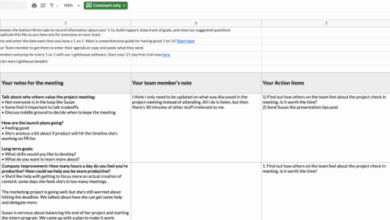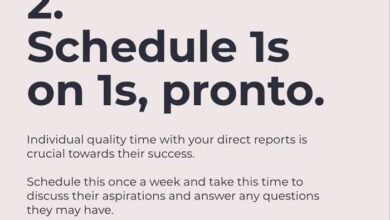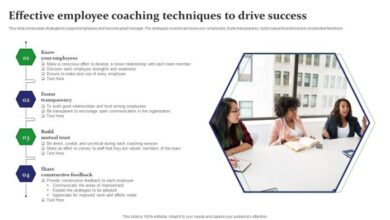
Mistakes managers make when having difficult conversations can significantly impact employee relationships and the overall work environment. This exploration delves into common pitfalls, from miscommunication to a lack of preparation, and how these errors can derail even the best-intentioned interactions. Understanding these missteps is crucial for fostering productive and respectful dialogue.
We’ll examine the various ways managers can unintentionally sabotage crucial conversations, including communication style, preparation, active listening, emotional responses, and overlooking underlying issues. By recognizing these patterns, managers can cultivate more effective strategies for navigating challenging conversations with employees, ultimately building stronger, more resilient teams.
Common Mistakes in Difficult Conversations: Mistakes Managers Make When Having Difficult Conversations
Navigating difficult conversations is a crucial skill for any manager. These conversations, often centered around performance issues, conflict resolution, or delivering critical feedback, can significantly impact employee morale and productivity. Successfully managing these interactions requires sensitivity, clarity, and a strong understanding of communication styles. Poor handling of such conversations can damage trust, create resentment, and ultimately hinder the overall work environment.Effective communication is not merely about transmitting information; it’s about fostering understanding and building rapport.
Managers who stumble in these crucial dialogues often miss key opportunities to address concerns, motivate employees, and improve team dynamics. Understanding the common pitfalls can equip managers with the tools to navigate these conversations with greater confidence and achieve more positive outcomes.
Common Communication Style Mistakes
Managers often falter in difficult conversations due to their communication style. These stylistic missteps can stem from a variety of factors, including ingrained habits, lack of awareness, or a lack of adequate training. Recognizing these patterns can empower managers to adapt their approach and foster a more productive and supportive work environment.
Top 5 Frequent Mistakes
These common mistakes can significantly impact the manager-employee relationship, and the overall work environment. They often stem from underlying psychological factors, such as fear of confrontation, the desire to avoid conflict, or a lack of training in effective communication strategies. Mistakes in difficult conversations can create a cycle of frustration and resentment.
| Mistake Type | Description | Impact on Relationship | Example Scenario |
|---|---|---|---|
| Avoidance | Avoiding the conversation altogether or delaying the feedback. This can lead to resentment and the issue escalating. | Creates a sense of distrust and uncertainty in the employee. It can lead to a deterioration of the working relationship. | A manager notices a colleague consistently missing deadlines. Instead of addressing it promptly, they wait until the project is significantly behind schedule, leading to further tension and resentment. |
| Vague Language | Using ambiguous terms or overly general feedback. This makes it difficult for the employee to understand the issue and how to improve. | Employees may feel unheard or unappreciated. They might struggle to identify specific areas needing improvement, resulting in a lack of clarity and motivation. | A manager tells an employee, “Your work isn’t up to par,” without providing specific examples or guidance on how to improve. |
| Emotional Responses | Allowing emotions to dictate the conversation rather than focusing on the issue at hand. This can create defensiveness and hinder constructive dialogue. | Employees may feel judged or attacked rather than supported. It can create a negative and hostile environment. | A manager yells at an employee for a mistake, leading to an emotional outburst and a breakdown in communication. |
| Lack of Active Listening | Failing to actively listen to the employee’s perspective or concerns. This can lead to a feeling of being unheard and dismissed. | Employees may feel unheard or unappreciated. They might struggle to identify specific areas needing improvement, resulting in a lack of clarity and motivation. | A manager cuts an employee off mid-sentence while discussing a problem, leading to a feeling of being dismissed and a lack of resolution. |
| Focusing on Blame | Pinpointing blame rather than focusing on solutions. This fosters a negative and adversarial environment. | Damages the working relationship and fosters resentment. Employees feel attacked and less motivated to improve. | A manager blames an employee for a project failure without exploring the contributing factors or possible solutions. |
Lack of Preparation and Planning
Difficult conversations, by their very nature, demand careful consideration and strategic planning. Failing to prepare adequately often leads to misunderstandings, frustration, and ultimately, less effective outcomes. Proactive planning ensures a more controlled and productive dialogue, allowing for a more constructive resolution. This preparation extends beyond simply knowing
-what* to say, but also
-how* to say it and
-what* the potential responses might be.
The Importance of Preparation
Thorough preparation is not just a good practice; it’s a cornerstone of successful difficult conversations. Effective managers recognize that the time spent planning is an investment in achieving the desired outcome. A well-prepared manager is better equipped to navigate the complexities of the discussion, maintain composure, and ultimately reach a mutually beneficial agreement.
Key Elements for Preparation
Before initiating a difficult conversation, managers must consider several key elements. These include understanding the context of the situation, defining the specific issues, anticipating potential reactions, and formulating clear objectives. Identifying the specific behaviors or situations causing the difficulty, along with a thorough understanding of the company’s policies and procedures relevant to the matter, are crucial.
Structured Framework for Planning
Developing a structured framework for difficult conversations facilitates a more organized and effective approach. This involves outlining the desired outcome, considering potential objections, and developing strategies for addressing those concerns. A step-by-step process for planning will help streamline the process.
Step-by-Step Guide for Preparing for Difficult Conversations
Effective preparation is a multi-faceted process. The following steps can serve as a guide for managers:
- Define the Issue: Clearly articulate the specific problem or behavior requiring attention. Avoid generalizations and focus on observable actions or statements.
- Gather Information: Collect all relevant data and documentation to support your points. This includes specific examples and dates of occurrences.
- Identify Objectives: Determine what you want to achieve in the conversation. Is it to address a performance issue, provide feedback, or seek a solution? Clearly define the desired outcome.
- Anticipate Reactions: Consider how the other person might react to your concerns. This involves acknowledging potential objections and formulating responses.
- Plan Your Approach: Artikel the sequence of your discussion, including how you’ll introduce the issue, present your concerns, and propose solutions.
- Practice the Conversation: Rehearse the conversation, focusing on maintaining a respectful and professional tone. Role-playing with a colleague can be highly beneficial.
- Prepare for Follow-up: Establish a plan for follow-up actions, including agreed-upon deadlines or next steps.
Effective vs. Ineffective Preparation Strategies
Effective preparation significantly increases the likelihood of a positive outcome in difficult conversations. Conversely, ineffective strategies can hinder progress and escalate tensions. The following table highlights the key differences:
| Effective Preparation Strategies | Ineffective Preparation Strategies |
|---|---|
| Clearly defined objectives and desired outcomes | Vague goals and lack of specific expectations |
| Thorough gathering of relevant information | Reliance on assumptions and insufficient data |
| Anticipating potential reactions and formulating responses | Unpreparedness for potential objections or challenges |
| Developing a structured approach to the conversation | Improvising during the conversation |
| Rehearsing the conversation | Entering the conversation without any prior practice |
Poor Active Listening Skills
Difficult conversations often require more than just talking points and prepared responses. Effective communication hinges on understanding the other person’s perspective, and this understanding is fundamentally rooted in active listening. Ignoring this crucial element can quickly transform a potentially productive discussion into a frustrating and unproductive exchange. This is a critical mistake that managers must avoid to ensure a positive outcome and foster a collaborative environment.Active listening is not simply hearing words; it’s a conscious effort to grasp the full message, including the verbal and nonverbal cues.
It’s about truly understanding the speaker’s perspective, emotions, and concerns, going beyond the surface level of their words. Failing to actively listen can lead to misinterpretations, missed opportunities for resolution, and ultimately, damage to relationships.
The Critical Role of Active Listening
Active listening is a cornerstone of effective communication, especially in difficult conversations. It allows managers to fully grasp the concerns and emotions of employees, understand their motivations, and tailor their responses accordingly. This empathy fosters trust and respect, paving the way for constructive dialogue and a more positive work environment. Understanding the speaker’s perspective prevents misinterpretations and allows for a more appropriate and helpful response.
Common Pitfalls in Active Listening
Several pitfalls can hinder effective active listening. Interrupting the speaker before they finish their thoughts is a common error. Pre-empting responses before the speaker is finished also prevents the listener from truly understanding the other person’s viewpoint. Another common mistake is mentally preparing a response rather than fully focusing on what the speaker is saying. This leads to a lack of empathy and understanding, and may result in missed crucial details.
Additionally, focusing on your own agenda or response instead of listening to the speaker’s concerns demonstrates a lack of attention and creates a barrier to mutual understanding. Finally, not paying attention to nonverbal cues, such as body language and tone of voice, can lead to a distorted understanding of the message.
Techniques for Demonstrating Active Listening
Active listening is a skill that can be developed through conscious effort. Several techniques can significantly enhance your listening skills and help navigate difficult conversations more effectively. These techniques are critical for fostering a productive and positive interaction.
- Summarizing and Paraphrasing: Restating the speaker’s message in your own words demonstrates your understanding and encourages them to clarify anything that may have been missed. This active feedback helps the speaker feel heard and understood.
- Asking Clarifying Questions: Instead of interrupting, ask open-ended questions to encourage the speaker to elaborate on their points. This shows genuine interest and allows for a deeper understanding of their perspective. It demonstrates that you are committed to understanding their message and avoiding misunderstandings.
- Reflecting Emotions: Acknowledging and validating the speaker’s emotions demonstrates empathy and understanding. This creates a safe space for open communication and fosters a stronger connection.
- Nonverbal Cues: Maintaining eye contact, nodding, and using encouraging body language demonstrates attentiveness and respect. This active engagement helps create a supportive environment for open discussion.
How Lack of Active Listening Escalates Difficult Conversations
The absence of active listening can significantly escalate difficult conversations. A lack of understanding can lead to misinterpretations, escalating emotions, and the creation of unnecessary conflict. Failing to grasp the speaker’s perspective can make the conversation adversarial, hindering the ability to find common ground. A lack of empathy can further exacerbate the situation, leading to a breakdown in communication and making a resolution harder to achieve.
Active Listening vs. Passive Listening
| Characteristic | Active Listening | Passive Listening |
|---|---|---|
| Focus | Fully concentrating on the speaker’s message, both verbal and nonverbal | Distracted, thinking about own response or other matters |
| Engagement | Asking clarifying questions, summarizing, and reflecting emotions | Minimal or no response to speaker’s message |
| Understanding | Seeking to understand the speaker’s perspective and concerns | Limited or no effort to understand the speaker’s message |
| Outcome | Improved communication, understanding, and resolution | Misunderstandings, escalating conflicts, and strained relationships |
Ineffective Communication Styles

Navigating difficult conversations requires more than just preparation and active listening. Effective communication relies on understanding and adapting various communication styles, particularly when dealing with sensitive or challenging situations. A manager’s communication style significantly impacts the outcome of these interactions, often determining whether the conversation remains productive or descends into conflict.
Communication Styles: Assertive, Aggressive, and Passive
Different communication styles reflect varying levels of self-expression and consideration for others. Understanding these distinctions is crucial for managing difficult conversations effectively. Assertive communication prioritizes expressing needs and opinions respectfully while also considering the perspectives of others. Aggressive communication, conversely, prioritizes personal needs and desires over the needs of others, often leading to conflict. Passive communication, on the other hand, often neglects personal needs and opinions to avoid confrontation, potentially leading to frustration and resentment.
Impact on Difficult Conversations
The communication style adopted directly influences the outcome of a difficult conversation. An assertive approach fosters open dialogue and mutual understanding, allowing for productive solutions. Aggressive communication often shuts down dialogue, creating defensiveness and hindering problem-solving. Passive communication can leave unresolved issues and resentment, potentially escalating the situation in the future. The ability to adapt one’s style to the situation and the individual is key.
Nonverbal Communication in Difficult Conversations
Nonverbal communication, including body language, tone of voice, and facial expressions, plays a significant role in difficult conversations. A calm and open posture can signal a willingness to listen, while crossed arms or a tense stance can signal defensiveness. The tone of voice can convey respect or hostility. Recognizing and managing nonverbal cues is as important as verbal communication.
Understanding how your nonverbal cues are perceived by the other party is crucial for a productive dialogue.
Managers often stumble when confronting tough issues, sometimes avoiding the conversation altogether. This avoidance, much like the recent decision by Sony to include Blu-Ray in their new budget-friendly Vaio laptops ( sony plugs blu ray on a budget with new vaio ), can create bigger problems down the line. Ultimately, open and honest communication, even when challenging, is key to a healthy and productive work environment.
Adjusting Communication Styles for Productive Dialogue
Adapting one’s communication style is essential for fostering productive dialogue. A manager should strive to be flexible and adjust their approach based on the individual and the situation. Understanding the emotional state of the other party and their communication style can significantly influence the effectiveness of the interaction. Being aware of how one’s own communication style is perceived by others is vital for success.
Techniques for Adjusting Communication Styles
Active listening, empathy, and clear articulation are fundamental to adjusting communication styles. Employing “I” statements to express personal needs and feelings while avoiding accusatory language can foster a more collaborative environment. Taking breaks to cool down when emotions escalate is crucial. Being mindful of nonverbal cues and adapting one’s body language and tone of voice accordingly can significantly improve communication effectiveness.
Examples of Communication Styles
| Situation | Assertive Response | Aggressive Response | Passive Response |
|---|---|---|---|
| Employee consistently misses deadlines | “I’ve noticed some missed deadlines recently. Could we discuss what’s causing this and brainstorm solutions?” | “You’re always missing deadlines! This is unacceptable!” | “I guess it’s fine if you miss the deadlines.” |
| Employee requests a raise | “I appreciate your request for a raise. Let’s discuss your contributions and how they align with our company’s compensation structure.” | “You think you’re worth more? We can’t afford that!” | “I’ll see what I can do.” |
| Client expresses dissatisfaction with a product | “Thank you for bringing this to our attention. Let’s work together to find a resolution that satisfies your needs.” | “You’re wrong! Our product is perfect!” | “I’ll pass this on to someone else to handle.” |
Emotional Responses and Bias
Difficult conversations are inherently emotionally charged. Managers, often caught in the middle of competing interests and perspectives, can find themselves overwhelmed by their own emotional responses. These responses, if not managed effectively, can cloud judgment and hinder productive outcomes. Understanding and mitigating these emotional responses, along with recognizing personal biases, are crucial for navigating these challenging interactions.Emotional responses during difficult conversations can range from frustration and anger to anxiety and fear.
These emotions can influence how managers perceive the situation, leading to misinterpretations and potentially unproductive outcomes. Personal biases, often unconscious, can further amplify these emotional responses, distorting the manager’s understanding of the situation and the other party’s perspective.
Impact of Emotional Responses on Managers
Emotional responses, whether positive or negative, can significantly impact a manager’s ability to handle difficult conversations. Strong emotions can lead to impulsive reactions, interrupting the flow of the conversation and hindering the manager’s ability to listen actively. This can result in misunderstandings, escalating tensions, and ultimately, an ineffective resolution. A lack of emotional regulation can also damage the manager-employee relationship.
Impact of Biases on Perceptions and Reactions
Biases, both conscious and unconscious, can significantly affect how managers perceive and react to difficult conversations. These biases can stem from various sources, including personal experiences, cultural backgrounds, and previous interactions. For instance, a manager might unconsciously favor employees who share their background, leading to a biased perception of performance. This can manifest as differential treatment or an inability to see the other person’s perspective objectively.
Strategies for Managing Emotional Responses
Effective emotional management is key to successful difficult conversations. Strategies include recognizing the signs of emotional escalation, taking a moment to breathe and collect thoughts, and consciously choosing to respond rather than react. Practicing mindfulness and emotional intelligence techniques can significantly improve a manager’s ability to navigate emotionally charged situations. Active listening and empathy can help diffuse tension and promote understanding.
Techniques for Recognizing and Mitigating Personal Biases
Recognizing and mitigating personal biases requires self-awareness and a commitment to continuous learning. Techniques include seeking feedback from others, actively challenging personal assumptions, and exposing oneself to diverse perspectives. Developing a strong understanding of one’s own biases and how they may influence interactions can help to ensure fair and objective decision-making. This includes actively seeking out and considering alternative viewpoints.
Case Study: The Impact of Emotional Responses and Biases
A manager, Sarah, was having a difficult conversation with a team member, David, regarding a project delay. Sarah, feeling frustrated by the repeated setbacks, immediately launched into a critique of David’s performance, accusing him of being careless. David, feeling defensive, countered with accusations of insufficient resources. The conversation spiraled into a heated argument. In hindsight, Sarah recognized that her frustration stemmed from past experiences with similar project delays and that her biases against employees who had exhibited similar patterns in the past influenced her reaction.
By understanding her emotional response and unconscious biases, Sarah could have taken a more measured approach, leading to a more productive and less confrontational conversation.
Failing to Address Underlying Issues

Difficult conversations often stem from deeper, more complex issues than surface-level disagreements. Simply addressing the immediate conflict without exploring the root causes can lead to recurring problems and damaged relationships. Managers need to delve beneath the surface to understand the motivations, concerns, and underlying factors driving the conflict.Effective managers recognize that resolving a surface-level issue without addressing the root cause is akin to treating the symptom rather than the disease.
This often results in a temporary fix that doesn’t prevent future problems. The key is to uncover the underlying issues and create a path towards sustainable solutions.
Managers often stumble when delivering tough feedback, much like Lara Croft in her earlier iterations, before she became the hardened adventurer. Instead of approaching the conversation with empathy and clarity, they often resort to vague pronouncements and accusatory tones. It’s a bit like watching a less-experienced Lara Croft struggle to navigate a challenging environment; a refreshing look at her past self might help us understand how to approach difficult conversations more effectively.
A good example of this is shown in the recent article on tomb raider refresh lara croft before she got so tough. Ultimately, effective communication requires a careful strategy and a focus on actionable solutions, not just criticism.
Identifying Underlying Issues
Understanding the root causes of conflicts requires active listening and a willingness to delve beyond the immediate complaint. This involves asking clarifying questions, encouraging the involved parties to share their perspectives, and acknowledging the emotional context behind the conflict. By focusing on the “why” behind the “what,” managers can uncover the true nature of the problem. Crucially, this approach promotes a more comprehensive understanding of the situation, fostering trust and collaborative problem-solving.
Managers often stumble when facing tough conversations, focusing too much on the “problem” instead of the person. It’s a bit like those scammers trying to trick hackers with a rigged cash machine, scammers try to hack hackers with crooked cash machine , a distraction from the real issue. Ultimately, effective communication involves empathy, active listening, and a clear path forward, not just pointing fingers.
Strategies for Constructive Dialogue
Facilitating a constructive dialogue to explore underlying concerns requires empathy and a structured approach. Open-ended questions can help uncover the root cause. For example, instead of asking “Why are you late?”, a more effective question would be “What challenges have you been facing that might be impacting your punctuality?” Active listening, paraphrasing, and summarizing the other party’s concerns demonstrate genuine interest and help ensure everyone feels heard.
Acknowledging and validating emotions, even if you don’t agree with the feelings, is critical. By creating a safe space for open communication, managers can encourage a deeper understanding of the underlying issues.
Techniques for Exploring Underlying Concerns
Techniques for exploring underlying concerns include using a structured problem-solving approach, focusing on specific instances, and using “5 Whys” to get to the root cause. In a problem-solving approach, identify the problem, brainstorm potential solutions, evaluate the solutions, and implement the best solution. Focusing on specific instances allows for a more detailed understanding of the situation, which can reveal patterns and root causes.
The “5 Whys” method involves asking “why” five times to uncover the underlying reasons for a problem. For example, if an employee is consistently missing deadlines, asking “why” five times might reveal issues like workload imbalance, inadequate training, or lack of clarity on expectations.
Avoiding Recurring Problems, Mistakes managers make when having difficult conversations
Ignoring underlying issues leads to a cycle of recurring problems. The surface-level conflict might be resolved, but the underlying issue remains, potentially leading to similar conflicts in the future. Addressing the root cause is crucial to prevent future conflicts and build stronger, more productive relationships. A lack of proactive investigation into the source of issues can result in significant lost productivity, wasted time, and damaged employee morale.
Table of Approaches to Identify and Address Root Causes
| Approach | Description | Example |
|---|---|---|
| Open-ended questioning | Asking questions that encourage exploration of underlying issues. | Instead of “Why did you miss the deadline?”, ask “What challenges did you encounter that prevented you from meeting the deadline?” |
| Active listening and paraphrasing | Paying close attention to what the other person is saying and summarizing their concerns to ensure understanding. | Paraphrasing: “It sounds like you’re feeling frustrated by the lack of resources to complete the project.” |
| Validation of emotions | Acknowledging and validating the other person’s emotions, even if you don’t agree with them. | “I understand your frustration with the current situation.” |
| Structured problem-solving | Following a systematic approach to identify the problem, brainstorm solutions, evaluate them, and implement the best solution. | Define the problem, generate ideas, evaluate options, choose a solution, and implement it. |
Inappropriate Use of Power Dynamics
Difficult conversations, especially those involving performance issues or disciplinary actions, can be significantly affected by the power imbalance between the manager and the employee. This imbalance can inadvertently skew the conversation, hindering productive dialogue and potentially leading to resentment and mistrust. Understanding how power dynamics play out and how to navigate them appropriately is crucial for effective management.Power imbalances in difficult conversations often manifest as a sense of unequal footing.
The manager, by virtue of their position, may feel entitled to certain responses or exert undue influence, while the employee might feel pressured to comply or intimidated into silence. This unequal distribution of power can create a climate where open and honest communication is stifled, potentially hindering the identification of root causes and effective solutions.
How Power Imbalances Affect Difficult Conversations
Power imbalances can significantly impact the outcome of difficult conversations. Managers holding significant power may unintentionally dominate the conversation, silencing the employee’s perspective and hindering the identification of shared solutions. Conversely, employees may feel intimidated and less likely to express concerns or offer constructive feedback, leading to a breakdown in communication and a lack of resolution. This dynamic can result in a feeling of unfairness or disempowerment for the employee, potentially damaging the working relationship.
Examples of Appropriate Power Use in Difficult Conversations
Managers can utilize their power appropriately by focusing on creating a safe and respectful environment for open communication. This includes actively listening to the employee’s perspective without interruption, acknowledging their feelings, and validating their concerns. Instead of immediately issuing directives, managers can collaboratively explore solutions and consider the employee’s input. For example, a manager might frame a performance issue discussion as a joint problem-solving session rather than a reprimand.
Emphasizing mutual respect and understanding can foster a more collaborative environment.
Techniques for Fostering a More Equitable Power Dynamic
Establishing a more equitable power dynamic requires conscious effort from both parties. Managers can initiate this by actively seeking the employee’s perspective and validating their feelings, even if they disagree with the employee’s point of view. This process encourages mutual respect and trust, paving the way for a more productive conversation. Furthermore, using inclusive language and active listening techniques helps demonstrate a commitment to understanding the employee’s viewpoint.
Framing the conversation as a collaborative problem-solving session rather than a confrontation can create a more equitable environment.
How Power Dynamics Lead to Resentment and Mistrust
The perception of unfairness or a lack of consideration for the employee’s perspective can quickly lead to resentment and mistrust. If a manager consistently uses their power to dominate conversations, or dismisses employee concerns, the employee may feel unheard and undervalued. This can result in a breakdown in the manager-employee relationship and a decrease in overall morale and productivity.
Such a dynamic is detrimental to the company’s overall well-being.
Case Study: The Unheard Voice
A manager, accustomed to issuing directives without much employee input, found themselves in a difficult conversation with a team member about a project delay. The manager, focusing on the project’s deadline, repeatedly interrupted the employee’s explanations of the obstacles faced. The employee felt unheard and frustrated. This pattern of behavior, driven by an imbalance of power, resulted in a breakdown of communication and a strained relationship.
The manager, lacking understanding of the impact of their actions, failed to create a space for the employee to feel valued and respected, resulting in a significant lack of trust. The situation escalated, ultimately impacting team morale and project outcomes.
Lack of Follow-up and Action Planning
Difficult conversations are rarely resolved in a single encounter. A crucial, often overlooked, aspect of effective management is the follow-up process. Without a clear plan for addressing the issues raised, the conversation’s impact can be diminished, leading to frustration and a lack of progress. This often results in a feeling of being unheard or dismissed, undermining the trust and respect that are essential for a productive working relationship.Effective follow-up goes beyond simply acknowledging the conversation.
It involves actively addressing the issues discussed and ensuring that everyone involved understands their role in the solution. This proactive approach builds confidence and strengthens the commitment to improvement. A well-structured follow-up process reinforces the importance of the conversation and demonstrates a genuine desire to implement changes.
Significance of Follow-up Actions
A strong follow-up reinforces the importance of the conversation and demonstrates a commitment to implementing changes. It signals that the issues raised are taken seriously and that a plan is in place to address them. This, in turn, fosters trust and encourages a more collaborative approach to problem-solving. Without a follow-up, the conversation risks being forgotten, or worse, perceived as a mere formality.
The absence of action often leads to a feeling of being unheard, undermining the employee’s motivation and productivity.
Strategies for Action Planning
Developing a clear action plan is essential for translating the discussion into tangible results. This plan should Artikel specific actions, responsible parties, and timelines for completion. The plan should be documented, shared with all involved parties, and regularly reviewed to ensure progress and identify any roadblocks. Using a structured format like a project management tool can enhance clarity and accountability.
This will help maintain focus and prevent the conversation from becoming forgotten.
Impact of Lacking Follow-up
The absence of follow-up significantly impacts the overall outcome of a difficult conversation. It creates a sense of disillusionment and disappointment, potentially leading to resentment and a lack of trust. This can manifest in decreased motivation, reduced productivity, and a decline in overall employee engagement. Essentially, the lack of action following the conversation negates its value and reinforces the perception that the manager isn’t truly invested in addressing the issues.
Improving Employee Engagement and Performance
A well-defined follow-up plan directly improves employee engagement and performance. Employees feel valued when their concerns are heard and acted upon. They are more likely to be invested in their work and committed to the organization when they see a clear connection between their contributions and tangible results. The proactive approach to resolving issues fostered by a follow-up plan strengthens the manager-employee relationship, leading to improved communication and collaboration.
Essential Steps in a Follow-up Plan
A well-structured follow-up plan is crucial for success. This plan should be detailed, shared with all involved, and revisited regularly. The following table Artikels the essential steps:
| Step | Description |
|---|---|
| 1. Document Key Takeaways | Summarize the key points discussed, agreed-upon actions, and responsibilities. |
| 2. Assign Responsibilities | Clearly define who is responsible for each action item and their deadlines. |
| 3. Establish Timeline | Set realistic deadlines for completing each action item. |
| 4. Communication Channels | Identify the best communication channels for updates and feedback. |
| 5. Regular Check-ins | Schedule regular meetings or check-ins to monitor progress and address any roadblocks. |
| 6. Evaluate and Adjust | Periodically review the progress, identify any issues, and adjust the plan as needed. |
Final Wrap-Up
In conclusion, mastering difficult conversations requires a multifaceted approach. By understanding the common mistakes managers make, from poor preparation to emotional responses, and by actively practicing effective communication strategies, leaders can foster a more positive and productive work environment. Ultimately, the key lies in proactive preparation, active listening, and a commitment to addressing underlying issues with empathy and respect.






